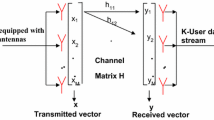Abstract
Massive multiple-input multiple-output (MIMO) technology has been proven to be a viable strategy for balancing the trade-off between energy efficiency (EE) and spectral efficiency (SE), which is key to the design of fifth-generation wireless cellular networks. In this work, we investigate the trade-off between EE and SE for downlink massive MIMO in wireless communication networks with respect to the power allocation problem. We maximize EE by deriving the signal-to-interference noise ratio for higher SE in the upper bound and propose that the EE–SE trade-off can be maximized when formulated as a Pareto-optimal solution based on the optimization problem. A Lagrange dual decomposition method is also developed for both transmit power allocation and the number of available antennas. From the simulation results, the maximum trade-off between EE and SE can be achieved based on the optimal transmit power allocation in every cell and when the number of base stations for the value of SE is high.



Similar content being viewed by others
References
Zi, R., Ge, X., Thompson, J., Wang, C. X., Wang, H., & Han, T. (2016). Energy efficiency optimization of 5G radio frequency chain systems. IEEE Journal on Selected Areas in Communications, 34(4), 758–771.
Ngo, H. Q., Larsson, E. G., & Marzetta, T. L. (2013). Energy and spectral efficiency of very large multiuser MIMO systems. IEEE Transactions on Communications, 61, 1436–1449.
Liang, N., Zhang, W. (2015). A mixed-ADC receiver architecture for massive MIMO systems. In IEEE information theory workshop (ITW), June 2015 (pp. 229–233).
Zhang, T. C., Wen, C. K., Jin, S., & Jiang, T. (2016). Mixed-ADC massive MIMO detectors: Performance analysis and design optimization. IEEE Transactions on Wireless Communications, 15(11), 7738–7752.
Liu, Z., Du, W., & Sun, D. (2017). Energy and spectral efficiency tradeoff for massive MIMO systems with transmit antenna selection. IEEE Transactions on Vehicular Technology, 66(5), 4453–4457.
Marzetta, T. L. (2010). Noncooperative cellular wireless with unlimited numbers of base station antennas. IEEE Transactions on Wireless Communications, 9(11), 3590–3600.
Héliot, F., Imran, M. A., & Tafazolli, R. (2012). On the energy efficiency-spectral efficiency trade-off over the MIMO Rayleigh fading channel. IEEE Transactions on Communications, 60(5), 1345–1356.
Aydin, O., Jorswieck, E. A., Aziz, D., & Zappone, A. (2017). Energy-spectral efficiency tradeoffs in 5G multi-operator networks with heterogeneous constraints. IEEE Transactions on Wireless Communications, 16(9), 5869–5881.
Hao, Y., Ni, Q., Li, H., & Hou, S. (2017). On the energy and spectral efficiency tradeoff in massive MIMO-enabled het nets with capacity-constrained backhaul links. IEEE Transactions on Communications, 65(11), 4720–4733.
Hao, Y., Song, Z., Hou, S., Li, H. (2015). Energy-and spectral-efficiency tradeoff in massive MIMO systems with inter-user interference. In IEEE in personal, indoor, and mobile radio communications (PIMRC), 2015 August 30, Hong Kong, China (pp. 553–557).
Chen, J., Chen, H., Zhang, H., & Zhao, F. (2016). Spectral-energy efficiency tradeoff in relay-aided massive MIMO cellular networks with pilot contamination. IEEE Access., 4, 5234–5242.
Chen, Y., Zhang, S., Xu, S., & Li, G. Y. (2011). Fundamental trade-offs on green wireless networks. IEEE Communications Magazine, 49(6), 30–37.
Deng, L., Rui, Y., Cheng, P., Zhang, J., Zhang, Q.-T., & Li, M.-Q. (2013). A unified energy efficiency and spectral efficiency tradeoff metric in wireless networks. IEEE Communications Letters, 17(1), 55–58.
Miettinen, K. (2001). Nonlinear multi objective optimization. In International conference on evolutionary multi-criterion optimization, 2001 March 7 (pp. 1–20). Berlin: Springer.
Marler, R. T., & Arora, J. S. (2004). Survey of multi-objective optimization methods for engineering. Structural and Multidisciplinary Optimization, 26(6), 369–395.
Amin, O., Bedeer, E., Ahmed, M. H., & Dobre, O. A. (2016). Energy efficiency spectral efficiency tradeoff: A multi-objective optimization approach. IEEE Transactions on Vehicular Technology, 65(4), 1975–1981.
Palomar, D., & Chiang, M. (2006). A tutorial on decomposition methods for network utility maximization. IEEE Journal on Selected Areas in Communications, 24(8), 1439–1451.
Wen, D., Yu, G., Li, R., Chen, Y., & Li, G. Y. (2017). Results on energy- and spectral-efficiency tradeoff in cellular networks with full-duplex enabled base stations. IEEE Transactions on Wireless Communications, 16(3), 1494–14507.
Boyd, S., & Vandenberghe, L. (2004). Convex optimization. Cambridge: Cambridge University Press.
Acknowledgements
The authors would like to thank the Ministry of Higher Education, Malaysia, under the Fundamental Research Grant Scheme (FRGS) (V.1627) and the Universiti Tun Hussein Onn Malaysia under Contract Grant (U550) for the generous financial support.
Author information
Authors and Affiliations
Corresponding author
Additional information
Publisher's Note
Springer Nature remains neutral with regard to jurisdictional claims in published maps and institutional affiliations.
Rights and permissions
About this article
Cite this article
Salh, A., Audah, L., Shah, N.S.M. et al. Trade-Off Energy and Spectral Efficiency in a Downlink Massive MIMO System. Wireless Pers Commun 106, 897–910 (2019). https://doi.org/10.1007/s11277-019-06194-4
Published:
Issue Date:
DOI: https://doi.org/10.1007/s11277-019-06194-4




